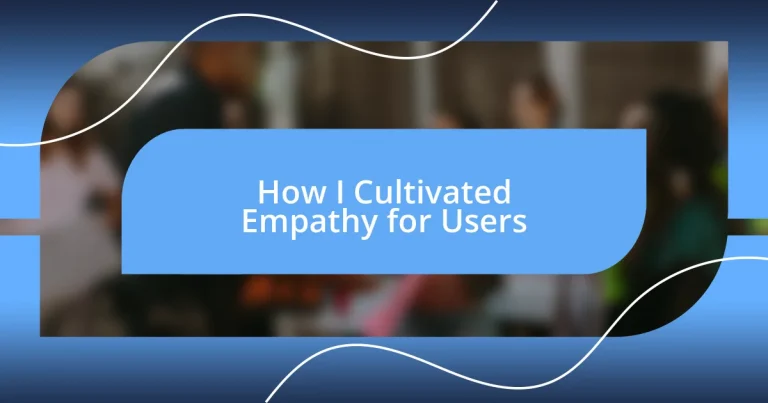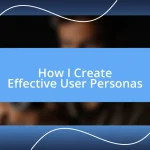Key takeaways:
- Empathy is cultivated through active listening, observing user emotions, and engaging in role-playing exercises to understand user experiences better.
- Personal reflections and community interactions can deepen empathy, revealing the real emotions users experience with products and highlighting the importance of connecting on a human level.
- Integrating empathy into daily work practices, such as analyzing user feedback and experiences, fosters a culture of understanding and enables continuous improvement in user-centered design.
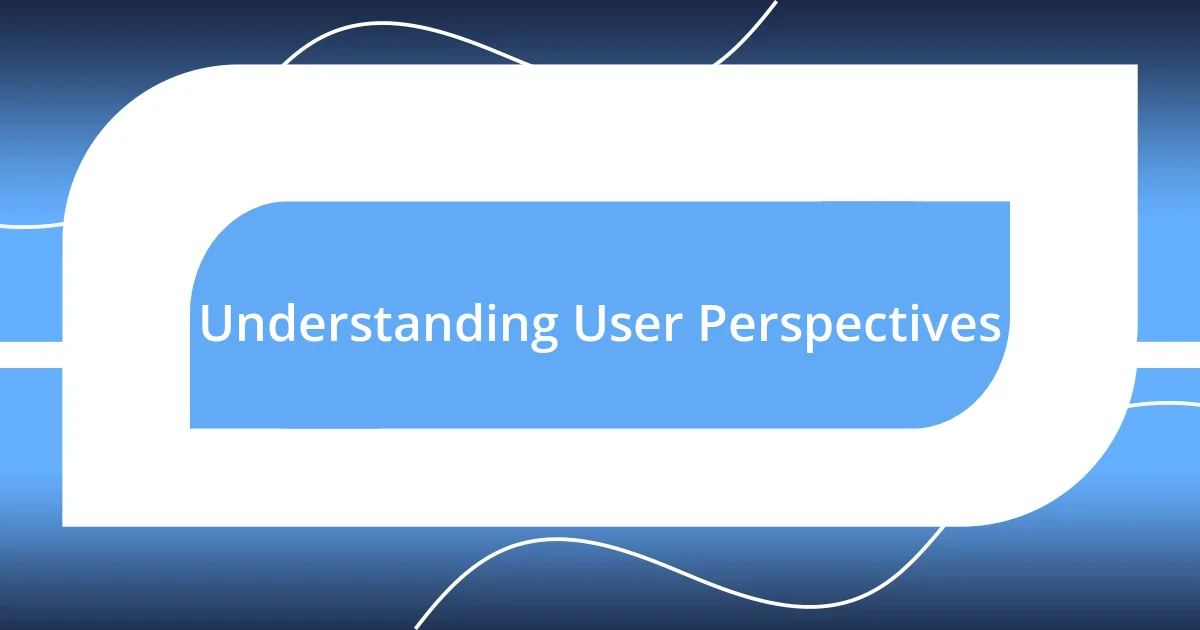
Understanding User Perspectives
To truly understand user perspectives, I often ask myself what my users are experiencing in their daily interactions with my product. I remember a time when I conducted user interviews, and one participant shared how a simple change I made had significantly eased their workflow. Hearing such real-world feedback brought a wave of realization about how small tweaks can make a big difference.
I recall an experience where a user expressed frustration over a feature they found confusing. Their emotions were palpable, and that moment made me reflect deeply on my design choices. It’s fascinating how stepping into someone else’s shoes can illuminate aspects of usability that I hadn’t considered before. Have you ever felt that way when you realized your work affected someone’s day-to-day life?
Empathy for users grows when we listen actively and observe closely. I’ve learned to engage not just with their words but also with their body language during usability tests. The tension in their shoulders or the furrow in their brow can convey just as much as their verbal feedback. This connection transforms data points into stories, reminding me that behind every click is a person with hopes, frustrations, and expectations.
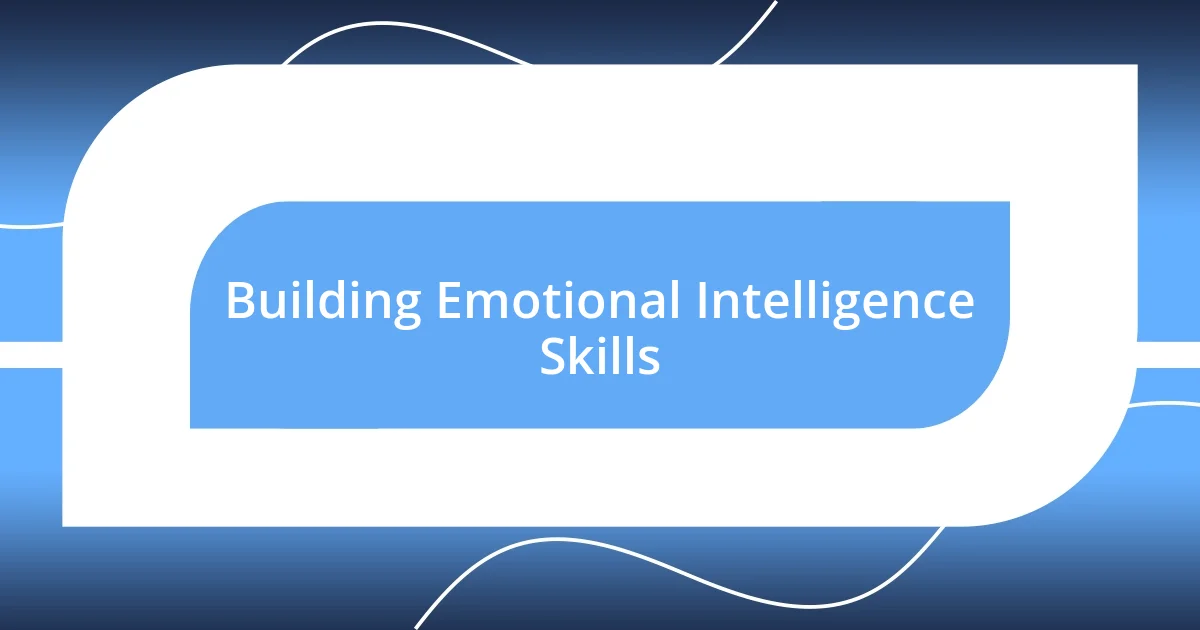
Building Emotional Intelligence Skills
Building emotional intelligence skills is essential for anyone looking to cultivate empathy in their work. I’ve found that tuning into my emotional reactions while interacting with users has helped me uncover deeper insights. For example, during a recent feedback session, I was surprised by how much empathy I felt when a user described their challenges. Their passion and frustration practically leapt off the screen, compelling me to not only listen but to connect with their experiences.
A key aspect of developing emotional intelligence is self-awareness. I’ve learned to take a moment to reflect on my feelings during user engagements. Once, I noticed that I felt defensive when a user critiqued a feature I worked hard on. Instead of brushing it off, I embraced that discomfort, using it as a catalyst to better understand their perspective. It reminded me that behind every critique lies an opportunity for growth, both for me and for the user experience.
Moreover, empathy can be cultivated through practice and feedback. I encourage my team to regularly engage in role-playing exercises where we simulate user experiences. This hands-on approach has given us invaluable insights into how our designs impact users emotionally. It’s a fun, yet powerful way to foster a sense of connection and understanding within our design processes. Have you ever tried putting yourself in someone else’s shoes in a similar way?
| Emotional Intelligence Skill | Personal Application |
|---|---|
| Self-awareness | Recognizing my emotional reactions during user interactions enhances my understanding. |
| Active listening | Listening not just to words, but also to the emotions behind them has deepened my empathy. |
| Empathy practice | Role-playing exercises help me and my team better understand user perspectives. |
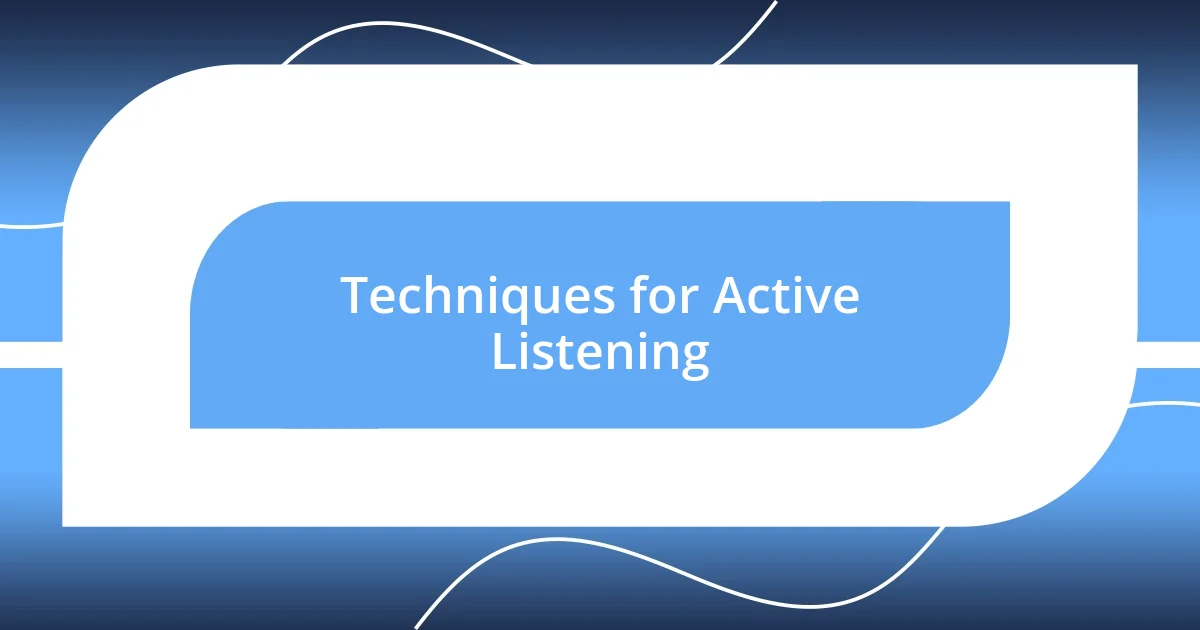
Techniques for Active Listening
Active listening is a powerful technique that allows us to connect with users on a deeper level. I remember a meeting with a user who seemed hesitant to share. Instead of jumping in with my thoughts, I focused on creating a safe space by nodding and encouraging them to elaborate. They opened up about their frustrations, revealing insights I hadn’t anticipated. This experience deepened my understanding of the importance of patience in listening; sometimes, silence invites users to share more of their truths.
Here are some practical techniques for active listening that I’ve found effective:
- Be present: Put away distractions, and maintain eye contact to show genuine interest.
- Reflect back: Paraphrase what the user says to confirm understanding and to demonstrate that you are engaged.
- Ask open-ended questions: Encourage users to elaborate by asking questions that require more than a yes or no answer.
- Observe body language: Notice non-verbal cues, such as facial expressions and posture, to gather additional context.
- Practice empathy: Respond with empathy, acknowledging their feelings and validating their experiences.
These techniques not only enhance the quality of the conversation but also foster a relationship built on trust and understanding. I’ve seen how such foundational interactions can lead to richer user insights, making it essential to cultivate this skill actively.
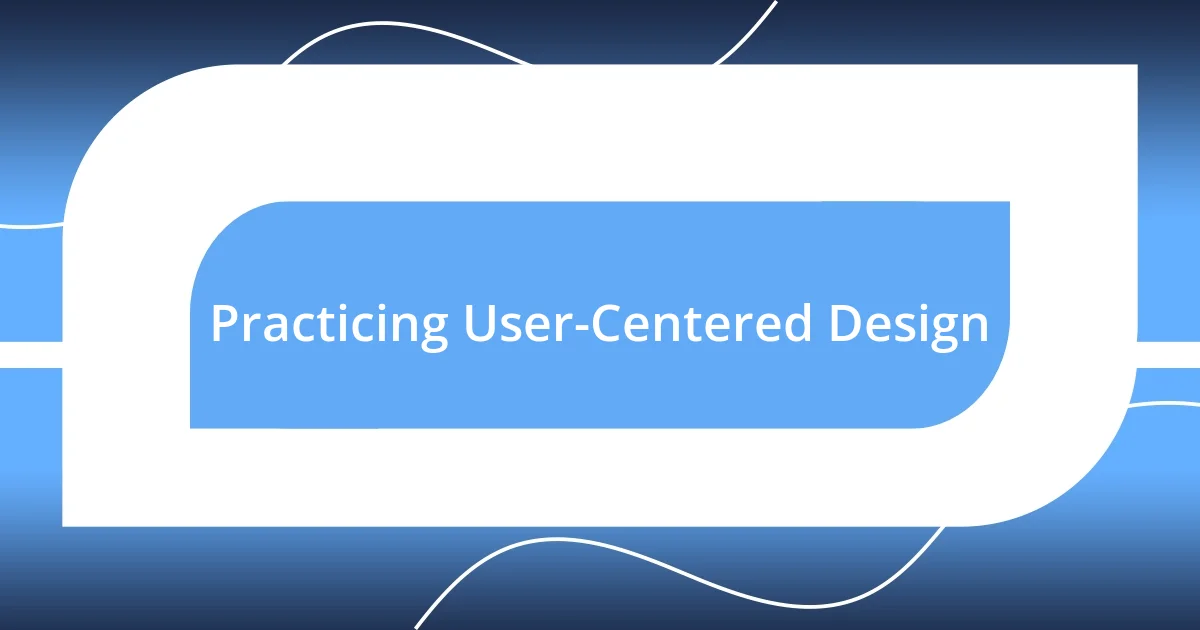
Practicing User-Centered Design
User-centered design isn’t just about the final product; it’s about the journey to understand the user. I distinctly remember a time when I participated in a user testing session that challenged my assumptions. A user pointed out a flowing design feature that I believed was intuitive, yet they found it confusing. That moment opened my eyes to the reality that what makes sense to us as designers may not resonate the same way with users. This realization made me rethink how I approach design choices, ensuring I always consider the user’s viewpoint.
Engaging directly with users has become a cornerstone of my practice. During one of my workshops, I invited participants to sketch their ideal experience with our app. The various interpretations left me both surprised and humbled. Each drawing reflected different needs and frustrations that I hadn’t fully grasped before. It made me question: how often do we, as designers, limit ourselves by assuming we know what the users want? Now, I prioritize incorporating user feedback at every stage, as this not only refines the design but truly embodies the essence of user-centered design.
Continuously practicing user-centered design can feel revolutionary. I remember implementing a session where team members took turns sharing personal stories about how they used technology in their daily lives. This helped my colleagues see the human side of our users and ignited a culture of empathy. When we weave these narratives into our design process, we don’t just create products; we create solutions that resonate emotionally. It’s a reminder that every interaction holds a story worth listening to.
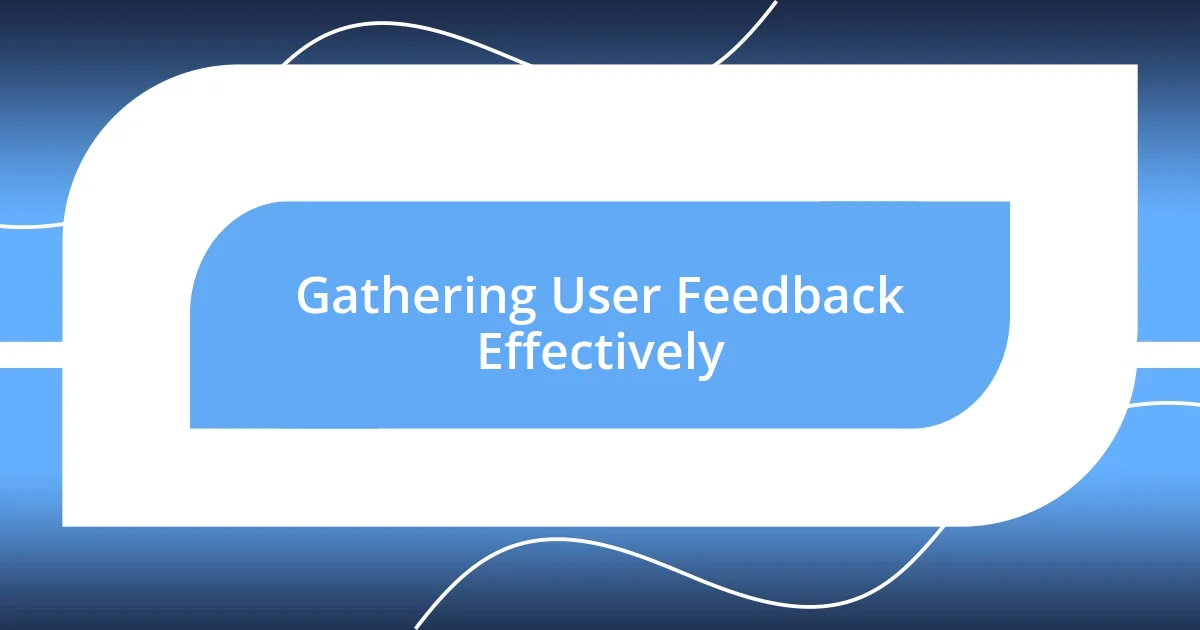
Gathering User Feedback Effectively
Gathering user feedback isn’t just about collecting data; it’s about creating meaningful exchanges. I try to approach these moments with curiosity. Once, during a casual coffee chat with a user, I found that informal settings often led to richer conversations. They shared thoughts about our product that they’d never mentioned in formal settings. Have you ever noticed how some ideas flow more in relaxed environments? It’s a gentle reminder that sometimes, we need to step away from structured feedback forms to really hear what users are saying.
When conducting surveys or interviews, I’ve learned the power of brevity and clarity. A few years back, I developed a short questionnaire for users to capture their experiences. The simplicity of the questions not only made it easier for them to respond, but it also revealed patterns in their feedback that I hadn’t expected. This approach reinforced the importance of asking the right questions – the ones that genuinely resonate with users’ experiences. In your practice, how do you ensure that your questions invite honest and valuable insights?
After analyzing user feedback, I always make it a point to share what I’ve learned with the team. I remember a time when a user pointed out a minor interface flaw that had been overlooked. Once we addressed it, user satisfaction improved drastically. This taught me that communicating feedback isn’t just about reporting results; it’s about fostering a culture where users feel acknowledged and valued. By consistently looping back to users, I reinforce their importance in our process, sparking continuous dialogue. How do you celebrate user-driven changes in your work?
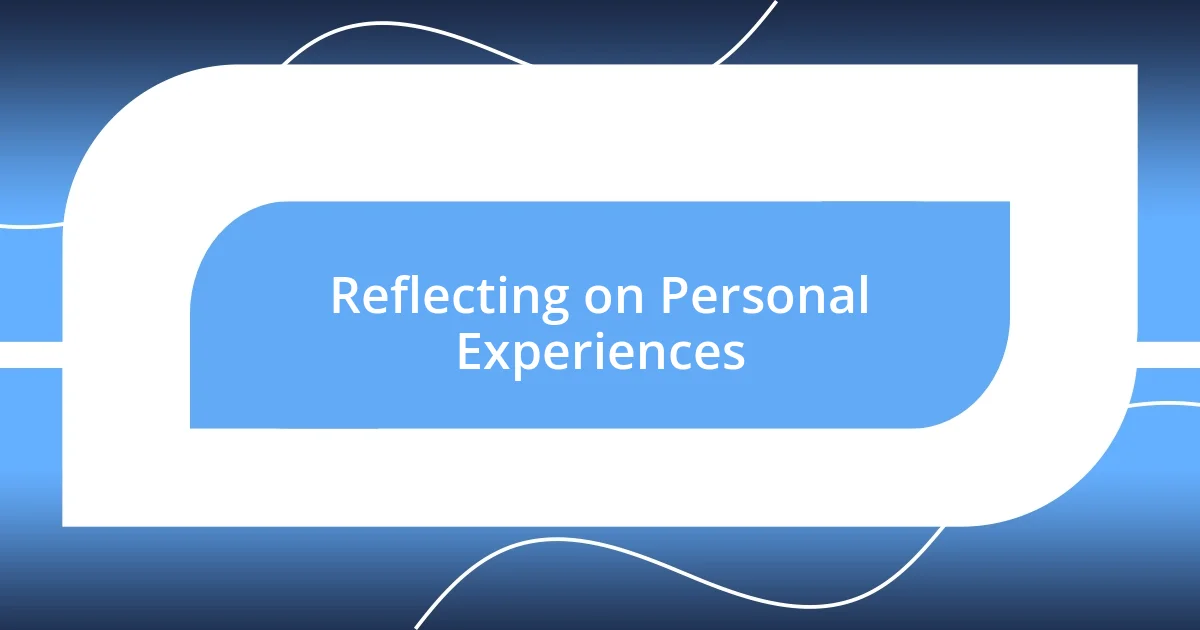
Reflecting on Personal Experiences
Reflecting on my personal experiences has revealed the depth of user emotions often overlooked in design processes. I once stumbled upon an old email from a user detailing their struggles with our software, expressing a sense of frustration and loneliness. Reading that letter made me realize how crucial it is to connect with the users’ emotions—after all, what we create impacts their daily lives, and understanding that connection sparked a fire inside me to foster empathy in my work.
In another instance, I volunteered to support a community project where users shared their stories about digital use in real-life contexts. As I listened to their struggles—like juggling multiple platforms and feeling overwhelmed—I couldn’t help but feel their pain. It made me wonder: how often do we get so caught up in our designs that we forget there are real people behind the screens? This experience not only deepened my empathy but also inspired me to create products that are not just functional but also emotionally supportive.
One of the most eye-opening moments for me was when I invited users to join a design brainstorming session. The raw passion and earnestness they shared about their experiences struck a chord with me. I distinctly remember a user saying, “I just want it to work for me without having to think too much.” Hearing their candidness compelled me to reconsider my assumptions about “user-friendly” design. Have you ever had a moment where user feedback completely shifted your perspective? Those revelations are the moments that truly cultivate empathy, enriching the user-centered design process beyond mere functionality.
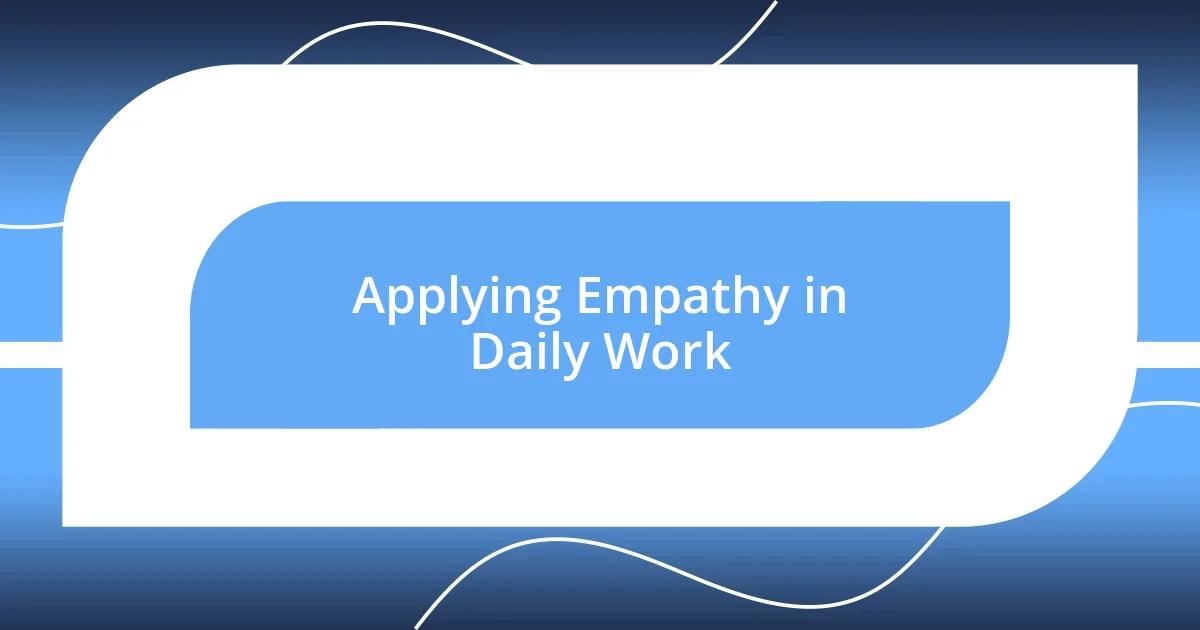
Applying Empathy in Daily Work
Applying empathy in daily work isn’t just a nice-to-have; it’s essential for building genuine connections with users. I remember a time when I collaborated with a support team during a particularly challenging project launch. We held a debriefing session, sharing stories about users’ frustrations. It dawned on me then that the emotional weight behind every complaint is an opportunity for growth. It’s fascinating how acknowledging users’ feelings can shift the perspective from merely resolving issues to improving the overall user experience.
Throughout my day-to-day tasks, I actively seek moments to step into the shoes of our users. During a routine meeting, I made it a point to ask team members about their own experiences with our product. Hearing them share personal anecdotes reminded me that we often overlook the insights gained from our own interactions with the tools we create. It’s a gentle reminder: have you ever thought about how your own experience could illuminate the paths for users?
Integrating empathy into my daily activities also means paying attention to details that might seem small but are significant. For instance, while reviewing user analytics, I often reflect on how data points translate into actual experiences. I recall analyzing a drop in user engagement; instead of just focusing on the numbers, I visualized the users behind those metrics. This shift in perspective helped me understand that every statistic represents a person—someone who may have felt frustrated or disengaged. How do you turn data into stories in your own work? By constantly asking these questions, I ensure that empathy remains at the heart of my daily efforts.












